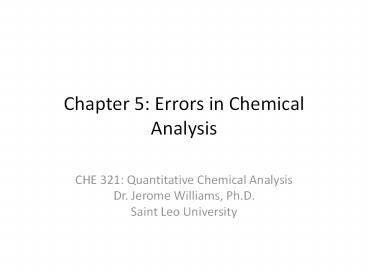Chapter 5: Errors in Chemical Analysis - PowerPoint PPT Presentation
1 / 22
Title:
Chapter 5: Errors in Chemical Analysis
Description:
Chapter 5: Errors in Chemical Analysis CHE 321: Quantitative Chemical Analysis Dr. Jerome Williams, Ph.D. Saint Leo University Overview Mean & Median Accuracy ... – PowerPoint PPT presentation
Number of Views:863
Avg rating:3.0/5.0
Title: Chapter 5: Errors in Chemical Analysis
1
Chapter 5 Errors in Chemical Analysis
- CHE 321 Quantitative Chemical Analysis
- Dr. Jerome Williams, Ph.D.
- Saint Leo University
2
Overview
- Mean Median
- Accuracy Precision
- Types of Errors in Data
- Random Errors
- Systematic Errors
- A Mean Calculation Using Excel
3
Mean Median
- Mean is arithmetic average of data set evaluated
as follows - Mean S Xi / N
- Median is the middle value of a data set when the
data are arranged according to increasing or
decreasing value - Odd numbered Data Set Median easily picked
- Even numbered Data Set Take mean of middle pair
- Review Example 5.1
4
Fig 5-1, p.91
5
Accuracy Precision
- Accuracy is the closeness of a measured value Xi
to the true or accepted value Xt - Often expressed as either absolute error or
relative error (percent, parts per thousand, or
parts per million) - Absolute Error (E) Xi - Xt
- Relative Error (Er) ((Xi - Xt ) / Xt ) 100
6
Accuracy Precision
- Precision describes the reproducibility of
measurements (closeness of results to others)
obtained in exactly the same way. - Three terms widely used to describe precision
include standard deviation, variance, and
coefficient of variation. All are functions of
deviation from the mean. - Deviation from Mean (di) Xi Mean
7
Fig 5-2, p.93
8
Fig 5-3, p.94
9
p86
10
p86
11
Types of Errors in Data
- Random Errors (Indeterminate Errors) affect
measurement of precision. - Systematic Errors (Determinate Errors) affect
accuracy of results. - Gross Errors occur as a result of human error and
often lead to outliers (results that differ
markedly from all other data in a set of
replicate measurements.
12
Types of Errors in Data
- Systematic Errors have a definite value and an
assignable cause, and are of the same magnitude
for replicate measurements made in the same way. - Systematic errors lead to bias in measurement
results. Bias can be negative or positive in sign.
13
Types of Errors in Data
- Three Types of Systematic Errors
- Instrument errors
- Method errors
- Personal errors
14
Types of Errors in Data
- Systematic Errors may be either constant or
proportional. - Constant errors are independent of the size of
the sample being analyzed. - Proportional errors decrease or increase in
proportion to the sample size.
15
Types of Errors in Data
- Detection of Systematic Errors
- Instrument errors resolved through calibration of
equipment. - Personal errors minimized by exercising care and
self-discipline. - Method errors are the hardest to overcome some
ideas to overcome this one include using standard
reference materials, independent analysis,
running blank determinations, etc.
16
p91
17
Excel Exercise 3 A Mean Calculation
- Construct the following in Microsoft Excel
18
p.100
19
p.101
20
p.102
21
p.102
22
Suggested Exercises
- HW Set 4 5.1, 5.5, 5.8, 5.12































